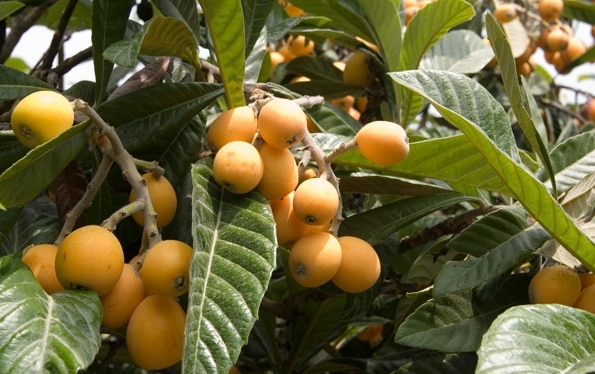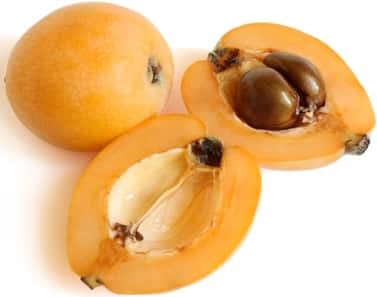Loquat Fruit Farming Guide:

Introduction of Loquat Fruit:- Loquat (Eriobotrya japonica) is an evergreen and large subtropical fruit tree growing 5 meter to 6 meter tall and spreading an equal distance Basically this fruit is scientifically grown in Japan, China, Taiwan and Korea. This fruit is native to central- eastern China. This fruit belongs to the family of “Rosaceae” and genus of “Eriobotrya”. This fruit is introduced in India in the name of “Japanese medlar”. In India, commercial cultivation of this fruit carried in the state of Uttar Pradesh, Punjab, Delhi, Assam, Himachal Pradesh and Maharashtra. In India, Loquat fruit is called Lukat or Lugath.
Health Benefits of Loquat Fruit:- The following are the health benefits of Loquat fruit.
- Loquat fruit Improves skin health condition.
- Loquat fruit Protects from colon cancer.
- Loquat fruit helps in improving eye vision.
- Loquat fruit may protect from lung and oral cavity cancers.
- Loquat fruit helps in maintaining blood pressure.
- Loquat fruit helps in weight loss.
- Loquat fruit helps in increasing haemoglobin.
- Loquat fruit strengthens bone and teeth.

Climate Requirement for Loquat Fruit Farming:- This fruit crop requires well distributed rainfall of 100 cm throughout the year. These fruits are very sensitive to frost conditions as well as sun burning. The cultivation of these fruits may be little difficult in regions where summer sets early along with hot winds.
Soil Requirement for Loquat Fruit Farming:- This fruit crop requires deep, well-drained, sandy loam soils rich in organic matter.
Varieties of Loquat Fruit:- There are so many varieties with different harvesting times are available. However, the following are the prime cultivars.
- Early Varieties: Golden yellow, improved golden yellow, pale yellow, large round and Thames pride.
- Mid-Season Varieties: Large Agra, Mammoth, Improved pale yellow, Matchless, Safeda and Fire ball.
- Late-Season Varieties: Tanaka and California advance.
Propagation in Loquat Fruit Farming:- Air-laying is most successful method of propagation in Loquat fruit farming. Treat the smooth and old-ringed shoots with 3 % of NAA or IBA 2500 ppm. Budded or grafted plants are preferred over seedlings in Loquat fruit farming due to early fruit bearing. Adequate farm yard manure can be supplemented while preparing the land to enrich the soil nutrition.
Land Preparation, Planting and Spacing in Loquat Fruit Farming:- Land should be prepared to make weed free and levelled. 2 or 3 deep ploughings should be given to bring the soil to fine-tilth stage. Planting is generally done in rainy season (monsoon). However, these can be planted any time of the year provided there is enough irrigation is available. The preferred spacing is 6 meter to 8 meter and 75 x 75 x 75 cm size of pits should be dug. These pits should be left to sunlight exposure for 2 to 3 weeks. Each pit can be added with 50 kg of FMY (well-rotten farm yard manure), 200 grams of single superphosphate along with 50 grams of Aldrin dust to ward off soil termites. A square system of planting can be adopted in Loquat fruit farming and 200 to 300 plants can be accommodated in 1 ha land for better yield. High-density of plantation also gives more yield in Loquat fruit farming.
Pests and Diseases in Loquat Fruit Farming:- Leaf roller caterpillar, aphids and fruit fly are major pests along with birds. These pests can be controlled by insecticides like carbaryl. Fruits need to be protected from birds as well. Black spot and Pseudomonas syringae pv.eriobotryae are main diseases found in this fruit farming. Black spot disease can be controlled by pre-blossom sprays of half-strength bordeaux.
Training and Pruning in Loquat Fruit Farming:- Central leader system or open system is followed in training of Loquat fruit farming. To establish a proper size and shape (basic framework), these trees needs to be pruned. Usually, these trees start flowering in July or August and continue till January or February. There are three flushes and flowering appears in the first flush is mostly shed. Flowering appears in 3rd flush would be poor and second flush flowering appears in Oct-Nov will be the major crop yield. Timely pruning should be carried out by snipping off 5 cm below the tips towards end of May month. Heavy pruning should be avoided as it causes more vegetative growth and low yield.
Intercropping in Loquat Fruit Farming:- Farmers can utilize inter-spaces during initial years of plantation for generating extra revenue. Any vegetable crops or low growing legume crops can be cultivated. Make sure these intercrops don’t use the fertility of prime trees of in Loquat Fruit. In case of intercropping, additional manure and fertilizers may be needed.
Irrigation in Loquat Fruit Farming:- Irrigation should be given based on soil moisture condition and weather condition. Generally, it requires frequent watering at the time of flowering. It requires about 3 to 4 irrigations at the time of harvesting.
Intercultural Operations in Loquat Fruit Farming:- As part of the inter-cultural operations, mulching needs to be carried out to retain the soil moisture. Mulch material like saw dust/dried leaves can be used. To control the weeds, keep the tree basins weed free and apply appropriate weedicides.
Manures and Fertilizers in Loquat Fruit Farming:- For better yield and quality, this crop requires heavy manures and fertilizers. Add an about 25 tonnes of well rotten farm yard manure /ha during the preparation of Land or Soil. In case of chemical fertilizers, N: P: K ratio of 750:300:750 grams /plant should be applied.
Harvesting in Loquat Fruit Farming:- Generally, these trees start bearing fruits from third year of plantation and give maximum yield @ 15 years. Fruits should be allowed to mature fully on the tree and never pull by hand as it causes decay. These fruits usually take 2 months to mature after the fruit set. The best way of harvesting is to use sharp instrument and pick bunches. Once harvesting completed, grading should be done based on the size and quality.
Yield in Loquat Fruit Farming:- Yielding depends on many factors like cultivar, soil, climatic conditions and farm management practices. Generally an average yield of 15 to 20 kg/tree can be obtained in Loquat fruit farming.
For sheep farming or goat farming info: Read here.
Where is the overseas market for loquat fruit
How do you process the leaf for herbal tea domistically